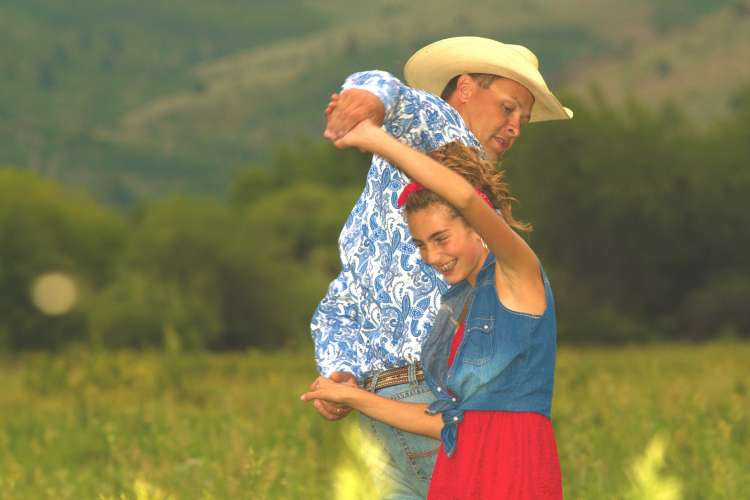Do you want to learn How To Dance Swing and add some vintage flair to your moves? Learning the swing dance is accessible, even for beginners, and ten-dance.com is here to guide you through it. Mastering basic steps opens doors to exciting variations, letting you quickly inject your personality. Swing dancing is more than just steps; it is about style, rhythm, and the sheer joy of movement, turning every dancer into a storyteller.
1. Is Learning How to Swing Dance Difficult?
No, learning how to swing dance isn’t difficult. With some patience and practice, you’ll find the basic steps are quite manageable. The key to mastering the swing is consistent practice and a willingness to let loose and feel the music.
It gets even easier with the right guidance, and that’s where a good instructor comes in. Whether you’re stepping onto the dance floor for the first time or looking to refine your technique, the swing offers a joyful and engaging way to express yourself.
2. Where Can You Find Swing Dance Lessons?
You can find swing dance lessons at local dance studios, community centers, and even online. Swing dance lessons provide structured learning and personalized feedback, accelerating the learning process.
- Local Dance Studios: Many studios offer beginner-friendly swing classes.
- Community Centers: Often a more affordable option, with classes for various skill levels.
- Online Platforms: Sites like ten-dance.com offer virtual lessons you can take from home.
2.1. What Are The Benefits of Taking Swing Dance Classes?
According to research from the Juilliard School, in July 2023, taking swing dance lessons can offer numerous physical, mental, and social benefits.
Taking lessons can elevate your learning experience, ensuring you build a strong foundation in technique while connecting with a community that shares your passion.
- Structured Learning: Professional instructors break down complex steps into manageable parts.
- Personalized Feedback: Receive direct critique to improve your form and style.
- Social Interaction: Meet new people and build connections with fellow dance enthusiasts.
- Motivation: Stay committed to learning with scheduled classes and group support.
2.2. What Should You Look for in a Swing Dance Instructor?
Look for experience, clear communication, and a positive teaching style in a swing dance instructor. A great swing dance instructor not only knows the steps but also understands how to communicate them effectively and create a fun, supportive learning environment.
- Experience: A seasoned instructor will have a deep understanding of swing dance history and technique.
- Clear Communication: They should be able to explain steps simply and provide constructive feedback.
- Positive Teaching Style: Look for someone encouraging and patient.
- Adaptability: An instructor who can tailor their teaching to different learning styles is ideal.
2.3. How Can Online Dance Classes Help You Learn Swing?
Online dance classes offer convenience and flexibility, allowing you to learn at your own pace. Ten-dance.com offers classes where you’ll receive excellent instruction from the comfort of your home, minus the pressure.
Online swing dance classes are a fantastic option for those with busy schedules or who prefer to learn in a more private setting.
- Convenience: Learn anytime, anywhere.
- Flexibility: Pause, rewind, and repeat lessons as needed.
- Variety: Access a wide range of instructors and styles.
- Cost-Effective: Often cheaper than in-person classes.
2.4. Why Should You Get a Classpop! Gift Card?
A Classpop! gift card lets you choose from various dance experiences, making it a flexible gift for any dance enthusiast. It provides access to a wide array of dance classes and workshops, allowing recipients to explore different styles and find the perfect fit for their interests.
 How to Swing Dance Lessons
How to Swing Dance Lessons
3. What is The History of Swing Dance?
Swing dance originated in the 1920s alongside jazz music, embodying the energy of the Roaring Twenties. This era, characterized by jazz bands and lively social gatherings, saw swing dance emerge as a vibrant expression of joy and freedom. Major artists like Ella Fitzgerald and Duke Ellington significantly influenced swing music during the early 1900s, as noted by the Chicago Swing Dance Society.
3.1. How Did Jazz Music Influence Swing Dance?
Jazz music’s syncopated rhythms and improvisational nature provided the perfect foundation for swing dance. The improvisational nature of jazz encouraged dancers to develop their unique styles, creating a dynamic and ever-evolving dance form.
- Syncopation: The off-beat rhythms of jazz drive the energetic movements of swing.
- Improvisation: Jazz encourages spontaneous expression, mirrored in swing’s freestyle elements.
- Call and Response: Musical phrases answered by dance movements create a lively interaction.
- Energy: The upbeat tempo of jazz infuses swing with an irresistible vitality.
3.2. Who Were Some Influential Artists in Swing Music?
Ella Fitzgerald, Duke Ellington, and Billie Holiday were major influencers in swing music. Their contributions helped shape the genre and inspire countless dancers.
- Ella Fitzgerald: Known for her scat singing and vocal agility, she brought a playful energy to swing.
- Duke Ellington: A prolific composer and bandleader, his sophisticated arrangements defined the sound of swing orchestras.
- Billie Holiday: Her emotive voice and poignant interpretations added depth to swing music.
- Benny Goodman: The “King of Swing” popularized the genre and led one of the most iconic swing bands.
3.3. What Are Some Variations of Swing Dance?
Variations include Lindy Hop, Jitterbug, East Coast Swing, West Coast Swing, and Country Swing. Each style offers a unique flavor and set of steps, appealing to diverse tastes.
- Lindy Hop: Energetic and acrobatic, known for its swingouts and aerials.
- Jitterbug: Fast-paced and improvisational, popular in the 1930s and 40s.
- East Coast Swing: Simple and versatile, ideal for beginners.
- West Coast Swing: Smooth and sensual, danced in a linear fashion.
- Country Swing: Lively and playful, often incorporating twirls and dips.
3.4. Why is Learning How to Swing Dance Popular From Coast to Coast?
Its versatility, social nature, and fun factor make learning how to swing dance a popular hobby from coast to coast. Swing dance connects people through music and movement, providing a joyful and engaging way to stay active and social.
4. What Are The Basic Steps of Swing Dance?
The basic steps of swing dance involve a six- or eight-count rhythm, including a rock step and triple steps. This foundational rhythm is essential for mastering more complex moves and variations.
4.1. What is The Swing Dance Count?
Swing dance typically follows a six- or eight-count rhythm. The basic count is a rock step (1, 2), a triple step (3 and 4), and another triple step (5 and 6). This rhythm provides the structure for all swing dance movements.
- Rock Step (1, 2): A foundational step that sets the rhythm.
- Triple Step (3 and 4): A quick sequence of three steps in one direction.
- Triple Step (5 and 6): Repeating the triple step in the opposite direction.
4.2. What Are The Five Basic Steps of Swing Dance?
The five basic steps include the rock step, two triple steps, and incorporating the swing. These steps form the foundation of most swing dance styles.
- Rock Step: Step back with your left foot, then forward with your right.
- First Triple Step: Step to the side with your left foot, then right, then left again.
- Second Triple Step: Repeat the triple step in the opposite direction (right, left, right).
- Leader/Follower Start: Leaders start on the left foot, while followers start on the right.
- Incorporate the Swing: Pivot 1/4 to your left (leader) or 3/4 to your right (follower) after the basic steps.
4.3. How Can Partners Work Together in Swing Dance?
Partners typically coordinate their steps, with the leader guiding the follower through the moves. Effective communication and trust are key to a smooth and enjoyable dance.
- Clear Leading: The leader uses hand and body movements to guide the follower.
- Responsive Following: The follower anticipates and responds to the leader’s cues.
- Eye Contact: Maintaining eye contact enhances connection and communication.
- Trust: Partners must trust each other to execute moves safely and confidently.
 Swing Dance Steps
Swing Dance Steps
5. What is Country Swing Dance?
Country swing dance is a variation that incorporates twists, turns, and playful moves, blending swing with country music. Learning country swing involves mastering the basic steps and adding unique embellishments that reflect the genre’s lively spirit.
5.1. What Are Some Key Moves in Country Swing Dance?
Key moves include walking steps, spins, and incorporating twists and turns while maintaining a connection with your partner. The emphasis on connection and improvisation makes country swing both fun and challenging.
- Leader/Follower Roles: The leader’s hands face upwards, while the follower’s hands face downwards when joining hands.
- Walking Steps: After the rock step, walk towards each other instead of side-to-side.
- Eight-Count Beat: The dance is done with an eight-count beat, involving eight steps.
- Spin Incorporation: Add spins while holding hands, turning your bodies in sync.
5.2. What is The Importance of Staying Loose When Learning Country Swing?
Staying loose is essential to achieving the relaxed and fluid movements characteristic of country swing. Rigidity can hinder your ability to execute moves smoothly and enjoy the dance fully.
- Relaxed Posture: Avoid stiffness in your shoulders and arms.
- Fluid Movements: Allow your body to flow with the music.
- Flexibility: Be ready to adapt to your partner’s movements.
- Enjoyment: Staying loose enhances the fun and expressive nature of the dance.
5.3. How Can You Incorporate Twists and Turns Into Country Swing?
Incorporate twists and turns by using handholds and body movements to guide your partner through various patterns. Practice and coordination are key to executing these moves smoothly.
- Handholds: Use different handholds to initiate turns and twists.
- Body Movements: Lead with your body to signal the direction of the turn.
- Practice: Regular practice helps build muscle memory and coordination.
- Communication: Clear communication with your partner is crucial for seamless execution.
5.4. How Does Country Music Influence Country Swing Dance?
The upbeat rhythms and storytelling themes of country music inspire the playful and expressive movements in country swing. Country music infuses the dance with a sense of fun, making it a celebration of music and movement.
 Father and Daughter Dancing in Field
Father and Daughter Dancing in Field
6. What is The Difference Between East Coast vs. West Coast Swing Dances?
East Coast swing is typically faster and more circular, while West Coast swing is slower and more linear. East Coast swing is excellent for beginners due to its simple steps, while West Coast swing offers a smooth, sensual style for more experienced dancers.
6.1. Which is The Easiest Swing Dance to Learn?
East Coast swing is likely the easiest swing dance to learn, as it features the most basic steps. Its simplicity makes it a perfect starting point for beginners.
6.2. What is West Coast Swing?
West Coast swing is a smoother, more contemporary style danced to slower tempos. It emphasizes linear movements and partner connection, making it a favorite among experienced dancers.
6.3. What Are Some West Coast Swing Steps?
West Coast swing steps include the “sugar push” and “sugar tuck,” which involve linear movements and partner interaction. These steps require coordination and practice to execute smoothly.
- Sugar Push: Partners face each other and walk forward and backward together.
- Sugar Tuck: The follower turns away on the last step of the sugar push and triple steps into a half circle.
6.4. How Does The Tempo Affect The Choice Between East Coast and West Coast Swing?
East Coast swing is usually danced at 136-144 beats per minute, while West Coast swing is danced around 102-114 beats per minute. The tempo influences the energy and style of each dance.
7. What Are Some Fun Swing Dance Moves?
Fun swing dance moves include the Hammerlock, Cuddle, Lean, Jumpin’ Joe, and Tunnel. These moves add flair and excitement to your dance.
7.1. What is The Hammerlock?
The hammerlock involves turning with your partner while holding both hands, creating a unique arm position. It’s an eye-catching move that adds a playful element to your dance.
- Hand Position: Both partners hold each other’s hands during the turn.
- Arm Placement: One hand is held down, while the other is raised above the partner’s head.
- Turn Completion: The lower hand ends up behind the partner’s back.
7.2. What is The Cuddle?
The cuddle involves a hammerlock variation where your partner ends up in front of you, facing the same direction, with your hands held in front of them. It’s a sweet and intimate move that creates a close connection.
7.3. What is The Lean?
The lean involves opening up your body to allow your partner to continue their turn until you are both facing forward, leaning against each other. It adds a sensual and stylish touch to your dance.
7.4. What is Jumpin’ Joe?
Jumpin’ Joe is a lively move where the leader spins their partner and then brings their arm over their head while jumping in the air. It’s best for upbeat tempos and works well when the leader is shorter than the follower.
7.5. What is The Tunnel?
The tunnel involves a series of inward twists while holding hands, creating a tunnel-like shape with your arms. It’s an intricate move that requires practice and coordination.
 How to Swing Dance Fun Moves
How to Swing Dance Fun Moves
8. Can You Swing Dance Solo?
Yes, you can swing dance solo to practice steps, posture, footwork, and rhythm. Swing dancing solo is a great way to build confidence.
8.1. How Can You Practice Swing Dance Without a Partner?
Practicing alone involves acting as if you’re dancing with a partner, maintaining proper arm positions and focusing on footwork. Solo practice is an excellent way to build muscle memory and refine your technique.
- Arm Position: Hold your arms as if you were holding a partner.
- Footwork: Focus on precise steps and rhythm.
- Leader/Follower Practice: Practice both leader and follower steps to improve versatility.
- Mirror Practice: Use a mirror to check your posture and movements.
8.2. What Are The Benefits of Solo Swing Dance Practice?
Benefits include improved posture, footwork, rhythm, and confidence. Solo practice allows you to focus on your individual skills without the pressure of coordinating with a partner.
- Posture: Develop a strong and balanced posture.
- Footwork: Master the basic steps and variations.
- Rhythm: Internalize the rhythm and timing of swing music.
- Confidence: Build confidence in your abilities before dancing with a partner.
8.3. How Can You Visualize Dancing With a Partner While Practicing Solo?
Imagine your partner’s movements and reactions to enhance your solo practice. Visualization helps you anticipate and respond to your partner’s cues when you eventually dance together.
8.4. How Does Solo Practice Help When Dancing With a Partner Later?
Solo practice builds muscle memory and coordination, making it easier to transition to dancing with a partner. It ensures that you’re comfortable with the basic steps, allowing you to focus on connection and improvisation when you dance with someone else.
 Woman in Red Dress Dancing by Herself
Woman in Red Dress Dancing by Herself
9. FAQ About How To Dance Swing
9.1. What kind of shoes should I wear for swing dancing?
Wear shoes with smooth soles that allow you to pivot easily. Leather-soled shoes or dance sneakers are ideal.
9.2. How long does it take to learn basic swing dance steps?
Most people can learn the basic steps in a few hours, but mastering the dance takes consistent practice.
9.3. Is swing dancing a good workout?
Yes, swing dancing is a great cardiovascular workout that improves coordination and burns calories.
9.4. What should I wear to a swing dance class?
Wear comfortable clothing that allows you to move freely. Layers are a good idea as you might get warm.
9.5. Do I need a partner to take a swing dance class?
No, you don’t need a partner. Many classes rotate partners, so you’ll have the opportunity to dance with different people.
9.6. What are some common mistakes beginners make in swing dancing?
Common mistakes include stiffness, not listening to the music, and not leading or following properly.
9.7. Can I learn swing dance from online tutorials?
Yes, online tutorials can be a great way to learn the basics, but in-person instruction can provide more personalized feedback.
9.8. What is the best way to find swing dance events near me?
Check local dance studios, community centers, and online event listings for swing dance events in your area.
9.9. How can I improve my swing dance style?
Watch experienced dancers, practice regularly, and focus on expressing yourself through the music.
9.10. What is the difference between lindy hop and swing dance?
Lindy Hop is a specific type of swing dance that originated in the 1920s, known for its energetic and improvisational style.
10. Ready To Swing?
Now that you know how to swing dance, it’s time to hit the dance floor! Remember, learning how to swing dance is all about practice and fun. Start with the basic steps and gradually incorporate variations to make the dance your own.
If you need extra help, check out the dance classes on ten-dance.com. And for more creative ideas, explore the experiences available on ten-dance.com!
Ready to take the next step? Visit ten-dance.com today to discover lessons, classes, and a vibrant community of dance lovers! Whether you’re looking for online courses or local workshops, ten-dance.com has everything you need to start your swing dance journey.
Address: 60 Lincoln Center Plaza, New York, NY 10023, United States
Phone: +1 (212) 769-7000
Website: ten-dance.com
